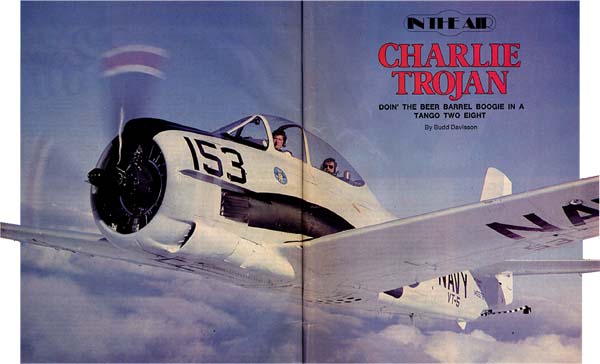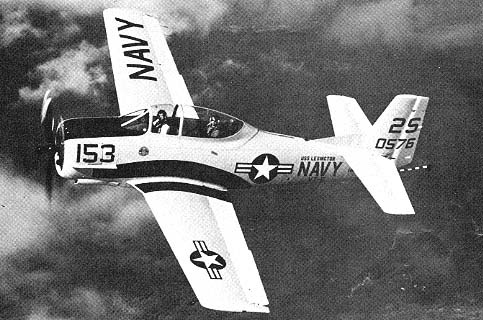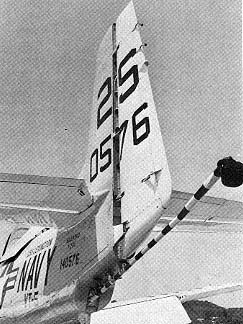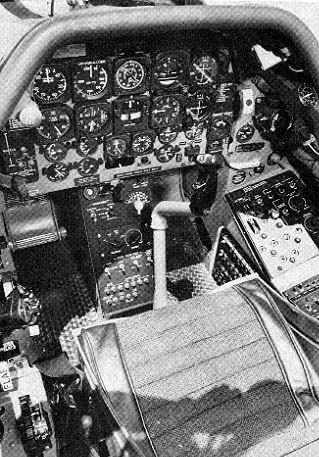

It's really kind of hard to categorize the T-28, especially the Bravo and Charlie models the Navy used. Set one next to the snarky looking Mustang, the T-28 comes off as a giant beer keg standing on tiptoe. But put them in the air, at power settings which burn the same fuel as the more famous fighter, and the T-28 will run right with the much sleeker (what an understatement!) Mustang. Yeah, it's a trainer, but it's hardly a quiet, retiring school marm.
Of course the Mustang (or Corsair, or Wildcat, etc.) was a combat fighter, so the T-28 doesn't have that glamour-boy image which combat gave the others.or does it? Of all the fighters which have survived the war, most of them served out their hitch stateside, never having fired a shot in anger. But the T-28? Herds of old A models were hotrodded with bigger engines and gun pods hung under the wings, and did a lot of shooting in various unpleasant parts of the world. And what about the Charlie models that somehow (who said CIA?) wound up with mercenaries in Zaire? Not only did they spend a lot of time chasing rebels (the definition of rebel depends on which side you are on) around with guns and rockets blazing, but at least a few of them did some "taking" as well as "giving." If you don't believe that just ask Ron Donley . If you can poke through the log book of his Charlie model, pay particular attention to the entry made on 29 March 1966. Under the "repaired" column it reads, in part, "Bullet hole in L. wing, Fwd spar, STA 28-8-36, through top, root fillet. 2. Bullet hole, R. wing fwd spar, right through. 3. Bullet hole, R. wing outboard of gun nacelle, punctured fuel cell." It goes on for six entries, all of them starting out with the words "bullet hole." The most interesting one came in through the pilot's floor and out through the cockpit hood sun shield. Who said the "T" stands for Trainer? It can also stand for terror.
Ron Donley, of Attleboro, Massachusetts, is one of the few folks around who have decided to have a go at the big engine 28s. It's not that the B and C models aren't popular, but they are in super short supply. It's hard to get a real good handle on the actual number of civil Charlie Models around. Only three came back from Zaire. However, the friendly USN troops down at Pensacola have turned a few of them loose to museums and such. Unfortunately they also chopped up forty or fifty of them. All of this went on in the past few months and very, very few warbird types knew about the possibility of weaseling a Charlie out in one piece. Too bad! There was another chance for us taxpayers to see a few of our bucks returned and some airplanes saved at the same time.

Ron's Charlie represents one of those few opportunities where a civilian can own the same airplane the military is currently using. Right now herds of Charlie models are still bounding off the old Lexington, as off shore Pensacola as Navy baby birdmen shoot their first carrier landings. A few years back the Charlie was the main transition machine. Believe it or not, a student would solo this 8,400 pound chunk of cast aluminum with only forty-two hours total time and only fourteen hours in the Charlie. Can you imagine the average civilian forty-two hour rag leg soloing a 1,425 hp monster
The Charlie was the last production variant of the T-28. Naturally, the first model was the "A", which was the awkward combination of the biggest airframe they could design around the smallest engine then availableonly 800 hp. The French used hundreds of the Ables, but spun them off to the surplus market in the early sixties where they fetched $3,000 as is, or $3,500 licensed. Pound for pound that's cheaper than hamburger (but then, what isn't).
The Navy decided they preferred their airplanes to spend more time flying than lumbering down the runway trying to get off the ground, so they had the original R-1300 replaced with a 1,225 hp Wright 1820. That made a real jackrabbit out of a North American tortoise. With the new Bravo (aptly named, since that's probably what the first test pilots yelled) the Navy quickly leained that by mixing the 8,000 pounds of airplane with 170 'pounds of primary student (along with an occasional carrier landing), what they often wound up with was a flaming salad in the middle of a field somewhere because the T-28s began shedding wings. The trainers couldn't take the beating. Enter Charlie.
Charlie was designed to be worked hard. Even though it looks a lot like a Bravo, it ain't. It carries several hundred pounds of extra beef and a lot of redesigned structure aimed at holding the wings on in flight and keeping the tail attached during carrier landings. The Charlie's most identifying characteristic is the cut-out in the lower rear fuselage for the sixty-five pound tail-hook. Charlie is also fitted with a super high pressure front tire and a propeller which is eight inches smaller than the Bravo's airscrew. What you wind up with, unfortunately, is a heavier airplane with a smaller prop. (For deck clearance.) So, the military Bravo is faster than the military Charlie . . but Ron's Charlie isn't military. It's running a Bravo prop and has lost some of the military baby fat. It's also got a bigger Bravo nosewheel because the Charlie's nosewheel can sink right into a hot asphalt ramp and disappear like a gopher headed home.
 The log book on Donley's airplane
is interesting, even if you ignore the bullet hole repairs. In
the first place it was kicked out of the Navy in 1964 (after 2,500
carrier landings!) and, barely two months later, was in Zaire
doing all sorts of questionable things. It flew 1,800 hours as
a combat trooper before it was once again retired, this time in
1973. It then sat around the Zaire boonies (or whatever they have
over there) for four years before somebody decided it was
time to bring it back to the States. Eventually, it wound up at
KalAero in Kalamazoo, Michigan, one of the more prolific warbird
restoration shops around, where Ron bought the Trojan. He then
pointed Kal-Aero's John Ellis at the airplane, said "restore
it" and a year later the deed was done.
The log book on Donley's airplane
is interesting, even if you ignore the bullet hole repairs. In
the first place it was kicked out of the Navy in 1964 (after 2,500
carrier landings!) and, barely two months later, was in Zaire
doing all sorts of questionable things. It flew 1,800 hours as
a combat trooper before it was once again retired, this time in
1973. It then sat around the Zaire boonies (or whatever they have
over there) for four years before somebody decided it was
time to bring it back to the States. Eventually, it wound up at
KalAero in Kalamazoo, Michigan, one of the more prolific warbird
restoration shops around, where Ron bought the Trojan. He then
pointed Kal-Aero's John Ellis at the airplane, said "restore
it" and a year later the deed was done.
And we mean restored! With a capital $$! New airplanes leaving Wichita should only be in as good a shape. There isn't a nut or bolt in this huge collection of hardware that isn't new or overhauled. Now, we hear a lot about an airplane that's been restored, but it's not until you peek up inside the belly of something like this that you realize what a massive undertaking a restoration can be. There are enough hydraulic lines alone to plumb every house in East Keokuk. And Ron didn't let Ellis simplify anything. It even has the rocket and gun wiring totally overhauled and intact. Well, you can never tell when you'll run into rebel forces and may want to make a buck as a mercenary.
Enough of the historical facts, let's get down to the important stuff, like how does it fly? In a word it does, and with 1,425 fat horses in that equally fat nose, it couldn't do anything but boogie.
Ron and his wife Claire (they have his and hers warbirds, hers is a polished 285 hp T-34) have been pleasant company at many airshows, so it was only natural that sooner or later we'd get around to flying his airplane. It turned out to be later, rather than sooner, however, since neither of our schedules dovetailed worth a hoot. It was worth the wait, however.
The second I walked up to his airplane, I knew Charlie Trojan was going to be something else. In the first place, the root of the wing is head high and even Kareem could walk under the tip, the dihedral is so pronounced. And the propeller tips are wider than most homebuilt wings! But bulk isn't always strength. That was hardly a question with the Charlie, however, since it has screws, bolts, rivets and everything else imaginable poking through the skin on the wings. Grumman apparently doesn't have the corner on the boilerplate approach to airplane design.
The flaps have conveniently placed steps cut into them but, with my foot in the bottom one, it was all I could do to reach the spring loaded handhold on the trailing edge of the wing walk. Geez, is this thing big! You don't know big until you're standing up on the wing and climbing into the cockpit. I'd forgotten my acrophobia until then.
 The cockpit sills are surprisingly
low, making the usually long step from the wing into the cockpit
no sweat. As a matter of fact, once you've put yourself in the
driver's seat you are extremely self-conscious, as if the entire
world is looking at you, perched up on top of Goliath's Piper
Cub. You stick out of the airplane from just above belly button
level and the view is fabulous. Between the view and the ballroom
accommodations you know for a fact that you re not in a WWII fighter,
where the cockpit is nothing but an aluminum foxhole with your
head sticking out.
The cockpit sills are surprisingly
low, making the usually long step from the wing into the cockpit
no sweat. As a matter of fact, once you've put yourself in the
driver's seat you are extremely self-conscious, as if the entire
world is looking at you, perched up on top of Goliath's Piper
Cub. You stick out of the airplane from just above belly button
level and the view is fabulous. Between the view and the ballroom
accommodations you know for a fact that you re not in a WWII fighter,
where the cockpit is nothing but an aluminum foxhole with your
head sticking out.
The rest of the cockpit is laid out ala North American; they haven't changed anything since the AT-6 first hit the streets. Any T-6 driver could find the right gadgets blindfolded: Flaps on rear of left console, trim wheels ahead of flaps, humongous throttle, engine goodies on the right forward console, radio stuff on top of right console. The only thing out of place for any T-6/P-51 jockey is the landing gear lever. It sticks out of the left side of the panel, where it should have been on the earlier airplanes (their's is clear down by your left foot).
Looking back, the most difficult part of dancing with a Tango Two Eight is getting it fired up as it feels as if Van Cliburn designed the starting sequence. The starter switch, primer button and mags are all on the forward end of the right console, carefully arranged so you can hit them all with the fingers of one hand. That sounds unnecessary except you have to crank the engine for twelve or thirteen blades, reach over with the other hand while it's still cranking and hit the mags, then when it starts firing and you're still cranking with your middle finger, you start tapping the primer button with your index finger. Then, when it's running on the primer (tap-tap-tap-tap) you bring the mixture up.
We strapped in and Ron sat in back giving me instructions and doing laps on his rosary beads. Okay, master on, cranking, counting, ten, eleven, twelve blades, mags on, tap the primer. Nothing. Still cranking and a little more prime. Still nothing. Crank, crank. We stop and analyze the situation since running the battery down could be bad news (ever try to prop a T-28?). Then Ron comes up on the ICS "Hey, did you turn the fuel on?" Dumb, Budd! Really dumb!
Crank, fire, tap-tap-tap-tap, roar, lots of noise and shaking and a tornado crawls over the windshield and into the open cockpit. I move the canopy handle to the closed position and thumb the hydraulic button on the lever. The canopy squeezes closed like something out of Star Trek and only the tornado stays outside. The roar is part of the interior decor.
There is no nosewheel steering (as on an A model), so I carefully picked my way through the Wichita Wonders to the runway and lined up on the numbers. Ron had cautioned me about keeping the manifold pressure down to 47 inches (47 INCHES! ) on take-off. So I studied the positioning of the airspeed and manifold pressure. I knew things were going to happen fast and I didn't want to have to spend much time looking for them when I needed them.
I double checked the rudder trim to be certain it was at six degrees right and put the elevator trim about neutral. Okay kid, let's do it.
I'd flown an "A" model before and, since they were both tricycle gear machines of about the same configuration and weight, I didn't expect any surprises. I was wrong! I moved my left hand forward and realized immediately that 600 extra ponies sure can drag the cart a lot faster. They can also try to push your nose into the weeds on the left. Seventy-five knots showed up on the gauge awful fast for a trainer and it was a relief to find that nailing the manifold pressure at forty-seven inches wasn't difficult. It also wasn't all that necessary since we'd rocketed up to eighty knots and I had rotated almost before I had full power. On later takeoffs I dropped the hammer a little faster and found things really got compressed. I forgot the rudder trim on one later takeoff and really got a surprise; even with the little wheel up front, this thing has as much torque as a Mustang.

I reached forward and gave the gear handle a tug with my left hand and waited for the little wheels to disappear in the panel. They didn't. Oh, oh! Ron's 100%-always-calm voice came up in my ears and told me to push the gear lever up. I did and found it still had a half inch to go. The wheel symbols disappeared, I relaxed and the airplane continued roaring upward at 120 knots and 2,000 fpm. At full power we showed 4,100 fpm up!
. As soon as the gear was up, and the power brought back to thirty-six inches and 2,400 rpm the airplane showed its true character by settling down to a 120 knot climb as if it was glued there. Dead stable! No wonder kids soloed it after only forty-two hours. This thing settled into a groove and like a streetcar.
In a few minutes the ground was 8,500 feet away and I was beginning to get a feel for Charlie, and I liked it. Nose level with power at twenty-seven inches and 2,000 rpm gave me an indicated speed of 203 knots (245 mph true). At that setting Ron says he usually burns about forty to fifty gallons an hour. If he pushes it up to sixty gallons an hour, which is also the economy cruise setting for a Mustang, he trues about the same as a Mustang.
Okay, so we know how fast it is. Who cares? The important things in life start at the end of a shallow 240 knot dive. Gentle pressure back on the stick and the nose follows my hand. I swivel my head to both sides and watch the wings.. cut their way vertically through the horizon in the early stages of a loop. With my head back, I watch the horizon work its way into the top of my field of vision with the blue on the bottom and the green on the top. I let the nose come down through the horizon and, while still inverted, pick out a farm with two silos ahead. The silos look upside down to me, but a little stick and rudder dance rolls the wings around the silo and it is once again right with the world. It does a Cuban eight exactly like it does everything else-- very smoothly and in a well-worn groove.
I do positive-G four and eight point rolls and find it has just a hint of roll inertia which has to be compensated, because it doesn't stop the second the ailerons are released. It also doesn't pirouette exactly around a point. A dancer of this size moves with a different style, with a little more elegance and maybe a hint of staidness It will do hesitation rolls all day long, but it is not a Pitts Special and doesn't plan to let you make believe it is one. It makes you work just a little more for your pleasures. Or are the pleasures merely of a different flavor?
Okay turkey, we've seen how you play, let's poke around in your dark side. The power comes back. When slowing down, the speed brake trigger on the top of the throttle comes in handy, as it gives you some much needed drag. With the brakes out, it sheds speed fairly easily until it gets under 100 knots, then a protracted fight begins to get the speed down to a dangerous level. At sixty to sixty-five knots, almost without warning, the aluminum slabs on either side decide they've had enough and stall. The break is a little sharp and totally free of warning buffet. Most importantly, the stall is uneven. Even with the ball perfectly centered, the left wing goes first and it quickly rolls in that direction. Stabbing the stick forward and punching the throttle up to twenty-five inches stops us in a thirty degree bank diving turn. Later, deeper stalls show that you have to move fast to keep it even close to level and Ron says some folks have found themselves on their back in an instant.
We picked out a nice little 3,000 ft. strip for touch and and I tucked the nose down to get us down to pattern altitude. The ground sure comes up quickly when the VSI says 3,000 down!
Ron says that although the Navy approach is eighty knots, he prefers to keep it at around ninety to 100 knots. At eighty knots, he says you use a lot of power to make the runway and it makes a Navy-style abrupt arrival the second you chop the power. I got it down to 120 on down wind and dropped the gear and half flaps. Abeam the numbers I had 100 knots and got the rest of the flaps out. Again I was pleased and relieved to see how speed-stable the airplane was. Roll in a little trim and the airspeed sits on the number you want until you ask it to sit on a different number. It is absolutely stable!.

It would add greatly to my hero-quotient, if I could tell a bunch of hair raising tales about the landing, but I can't. It bores down final like it's way ahead of you and all you have to do is maintain 100 knots and use the throttle and speed brake to put you where you want to be on the runway. In actual fact, my biggest problem was in overshooting the numbers slightly. It just wouldn't fall out of the air, like you would expect it to. However, once it was dirtied up, with the speed brake out, you could duck the nose down slightly and shed some altitude without picking up any speed. It was super easy to control.
Ron was ominously quiet in the back pit, but on final he'd pipe up every so often with a "Don't forget how long the gear is." I guess he's done this drill with somebody who threatened to plant the mains in the grass. He didn't have to say anything as I was acutely aware of how high off the ground I was sitting and the last thing I wanted to do was leave the main gear at the end of the runway. Gentle flare. Hold it off, hold it, clunk! And we were down. No sweat, which is absolutely amazing. I'm not one of those pilots who spends a lot of time in heavyweights and I was astounded at how little problem I was having.
After shooting a bunch of bounce and goes I found I still had problems figuring out exactly where the ground was. I'd consistently overcompensate and round out a little high. I could put it on smooth enough, if I'd power into the flare and gently bleed the power off, but then I'd use too much runway. I guess it just takes a little more practice.
I've got to say that Charlie really makes you feel like a super-hero with little or no effort on your part. It gives you big numbers and lets you play fighter pilot, but doesn't demand you be a wildly proficient driver. However, it should also be said that Charlie could easily lull you into a false sense of security and then take a giant chunk out of your posterior when you least expect it. At over 8,000 pounds, and 1,425 horses, there is no possible way it can be a pussy cat all the time.
It's a neat airplane alright, but would I like to own one? Hell yes! But, could I own one? Absolutely not! I knew my ability to play with warbirds was limited when Ron got ready to depart. We found the local airport was out of fuel and Ron was really worried because the nearest airport was thirty miles (less than ten minutes) and he had only thfrty-five gallons on board. My bird only holds twenty-two gallons and I can't really afford to fill it! Maybe I can't afford something like a T-28C, but at least somebody can. And that's important. Without guys like Ron, there wouldn't be airplanes like Charlie.